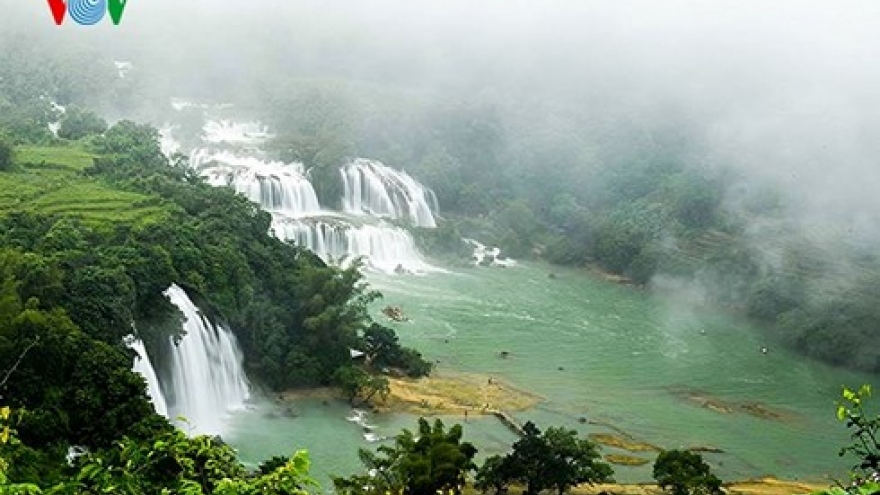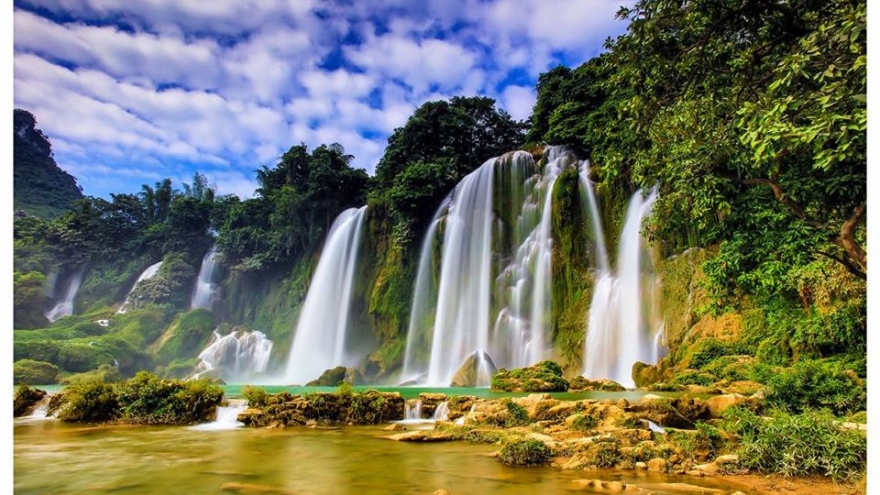Ban Gioc – a majestic waterfall
VOV.VN - Cao Bang province in northeastern Vietnam, bordering China’s Guangxi province, has some well-known historic sites, including including Le Nin stream and Pac Bo cave - the work place of President Ho Chi Minh during the resistance war.
 |
| Ban Gioc waterfall in Cao Bang province (Photo: Vinh Phong/VOV) |
Cao Bang province is also known for Nguom Ngao cave, Thang Hen lake, and Ban Gioc waterfall - the largest waterfall in Southeast Asia.
Ban Gioc waterfall in Dam Thuy commune, Trung Khanh district, is associated with a love story about a Tay ethnic minority couple.
Once upon a time, a prince fell in love with the most beautiful Tay lady in a village called Ban Gioc, who loved a Tay man from a neighboring village. Rejected, the prince grew so angry that he ordered the lady arrested and imprisoned in his palace.
The Tay man defied all dangers and successfully rescued his true love. Rain helped cover their escape.
When it stopped raining, the couple saw a waterfall spraying white foam and pouring water into a crystal clear river. The waterfall is now called “Ban Gioc” to commemorate story.
Under a Vietnam-China border delimitation treaty signed in 1999, Ban Gioc waterfall is divided into two parts. The lower waterfall is entirely in Vietnam’s territory, while the upper waterfall is half in Vietnam and half in China.
The upper waterfall has three levels that measure a total of 70 meters high, 60 meters long, and 300 meters wide. Ban Gioc waterfall feeds a large river called “Quay Son”, which is flanked by grass meadows and primeval forest. The river’s right bank is Vietnamese territory. Its left bank belongs to China.
Captain Do Ngoc Hao, head of the Ban Gioc waterfall border post, said, “The Quay Son river originates in China and snakes its way through five Vietnamese communes before returning to China. The river branches off at Dam Thuy commune, winds through the mountains, and descends at Ban Gioc waterfall. Ban Gioc waterfall is the highlight of Cao Bang provincial tourism development. Initiatives have been made to attract investment to this area. We, the border guards, are working to maintain security at Ban Gioc waterfall.”
In 1922, the Indochina Department of Geology called this area the most beautiful in Tonkin (northern Vietnam), worth a visit for its stunning waterfall, magnificent caves, and a bridge that zigzags over large rocks to cross the river.
In 1997, Ban Gioc waterfall was officially recognized as a national scenic spot. Ban Gioc waterfall is the world’s fourth largest border waterfall, after Iguazu Falls on the Brazil-Argentina border, Victoria Falls on the Zambia-Zimbabwe border, and Niagara Falls on the Canada-America border.
World renowned travel magazines have honored Ban Gioc as one of top ten most majestic waterfall on earth.
Joyce, a tourist from France, said, “I’m doing a voluntary trip in Vietnam and come to visit Ban Gioc waterfall. It’s really beautiful and fresh here. I have never been to any waterfall as beautiful as this in France.”
Ban Gioc waterfall is most beautiful between June and October, especially in September and October when it is full of water. The captivating waterfall is a great inspiration for poetry and music.


